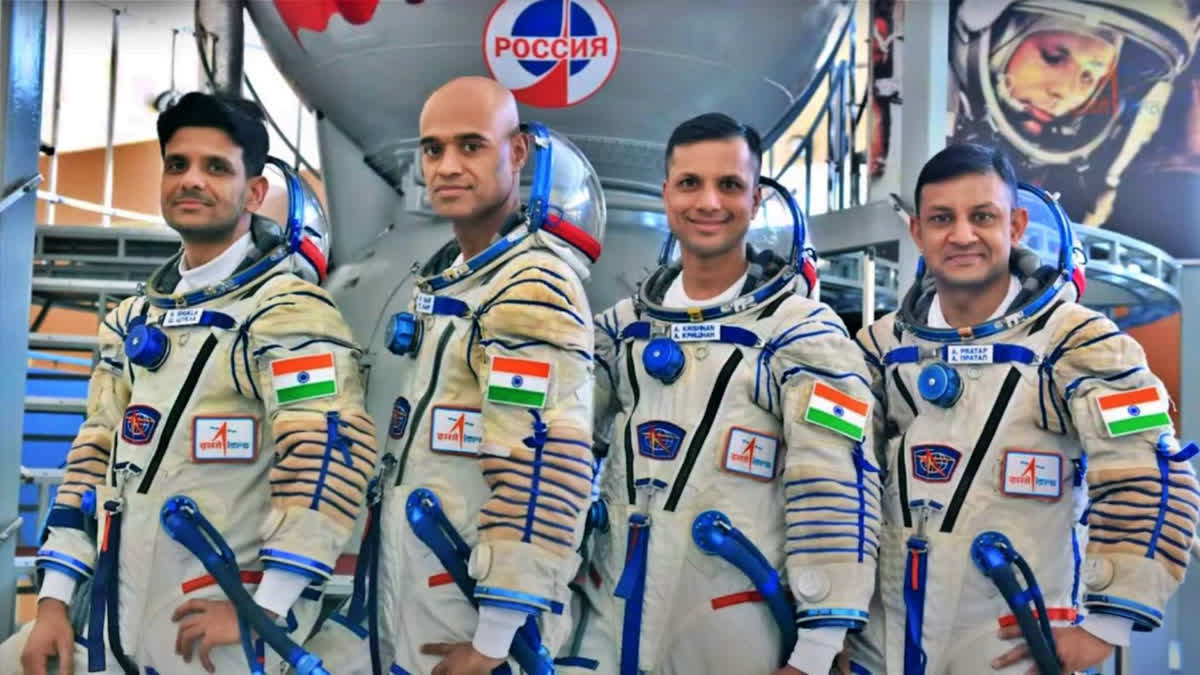New Delhi: When Prime Minister Narendra Modi on Tuesday bestowed the “astronaut wings” on Group Captain Prashanth Balakrishnan Nair, Group Captain Ajit Krishnan, Group Captain Angad Pratap and Wing Commander Shubhanshu Shukla, all test pilots of the Indian Air Force, you will tend to believe that the four of them will be India’s first astronauts.
After all, Wing Commander Rakesh Sharma, the only Indian citizen till date to travel in space is called a cosmonaut as he flew aboard Soyuz T-11 on April 3, 1984, as part of the then Soviet Interkosmos programme. But the fact of the matter is that Nair, Krishnan, Pratap and Shukla will not be India’s first astronauts. They will, in fact, be the world’s first vyomanauts.
This will be in keeping with the tradition of naming space travellers based on their national origin or language. It is rooted in the historical development of human space exploration programmes. Each country with an indigenous space programme tends to use a specific term to refer to its space travellers, reflecting linguistic and cultural aspects.
India is only the fourth country after the US, the then Union of Soviet Socialist Republics (USSR) or today’s Russia, and China to develop an indigenous human space travel programme. While the US calls its space travellers astronauts, the Russians call theirs cosmonauts and the Chinese people going to space are referred to as taikonauts.
The tradition of naming space travellers based on their national origin or language is rooted in the historical context of the Cold War-era space race between the US and the USSR. During the early years of human space exploration, each country developed its own human spaceflight programme, and the selection of terms for astronauts reflected national identity, cultural pride, and the political context of the time.
The US initiated its human spaceflight programme under the National Aeronautics and Space Administration (NASA) in the late 1950s and early 1960s. The term “astronaut” was chosen, drawing inspiration from Greek roots, reflecting the American commitment to peaceful space exploration. In Greek, “astron” means star, and “nautes” means sailor, so “astronaut” can be translated as “star sailor”.
The then NASA Administrator T Keith Glennan and his Deputy Administrator, Hugh Dryden, discussed whether spacecraft crew members should be called astronauts or cosmonauts. Dryden preferred “cosmonaut”, on the grounds that flights would occur in and to the broader cosmos, while the “astro” prefix suggested flight specifically to the stars. However, most NASA Space Task Group members preferred “astronaut”, which survived by common usage as the preferred American term.
American writer Neil R. Jones is credited with the earliest known use of the term “astronaut” in its contemporary sense, as seen in his 1930 short story “The Death’s Head Meteor”. However, the term itself had surfaced earlier; for instance, Percy Greg employed it in 1880 in his book Across the Zodiac, where “astronaut” referred to a spacecraft. J.H. Rosny aîné, in his 1925 work Les Navigateurs de l'infini, used the term “astronautique” (astronautics). It’s possible that the term drew inspiration from “aeronaut”, an older word denoting an air traveler first coined in 1784 for balloonists. The non-fiction realm saw an early instance of “astronaut” in Eric Frank Russell's poem “The Astronaut”, published in the November 1934 Bulletin of the British Interplanetary Society.
By convention, an astronaut employed by the Russian Federal Space Agency (or its predecessor, the Soviet space programme) is called a cosmonaut in English texts. The word is an Anglicization of the Russian term “kosmonavt”. “Cosmos” in Russian means space, and “nautes” (borrowed from Greek) means sailor, so “cosmonaut” translates to “space sailor” or “cosmic traveler”.
In April 1961, cosmonaut Yuri Gagarin from the Soviet Union became the first human to travel in space. His vehicle Vostok 1 circled Earth at a speed of 27,400 kmph with the flight lasting 108 minutes. Vostok’s reentry was controlled by a computer.
The very next month, Alan Shepard, on May 5, 1961, became the first American astronaut and the second man in space, when he piloted the Mercury spacecraft Freedom 7 on a 490-km, 15-minute suborbital flight.
China entered the human space programme with the launch of its first crewed mission, Shenzhou 5, on October 15, 2003. This mission carried Yang Liwei, a Chinese taikonaut, into space, making him the first Chinese person to travel into space. In Manadarin Chinese, “taikong” means space and “naut” as in Greek for sailor. This term is usually used in the West to refer to a Chinese space traveller. However, the official Chinese name for space travellers from the country is “yuhangyuan”, meaning “travellers of the Universe”.
It is in line with this tradition that space travellers emerging from India’s indigenous human space programme will be called “vyomanauts”. In Sanskrit, “vyoma” means space; “naut” as in Greek for sailor. The term has reportedly been coined by the Indian Space Research Organisation (ISRO).
Three vyomanauts will man Gaganyaan, the first Indian crewed orbital spacecraft. While Prashanth Nair and Angad Prathap have been confirmed as the first two vyomanauts, Ajith Krishnan and Subhanshu Shukla will vie for the third spot.
Read More
- PM Modi Reveals Four Pilots Chosen For Gaganyaan Mission, Presents 'Astronaut Wings'
- Cryogenic Engine For Gaganyaan Missions Now Human-Rated, Says ISRO
